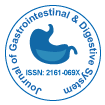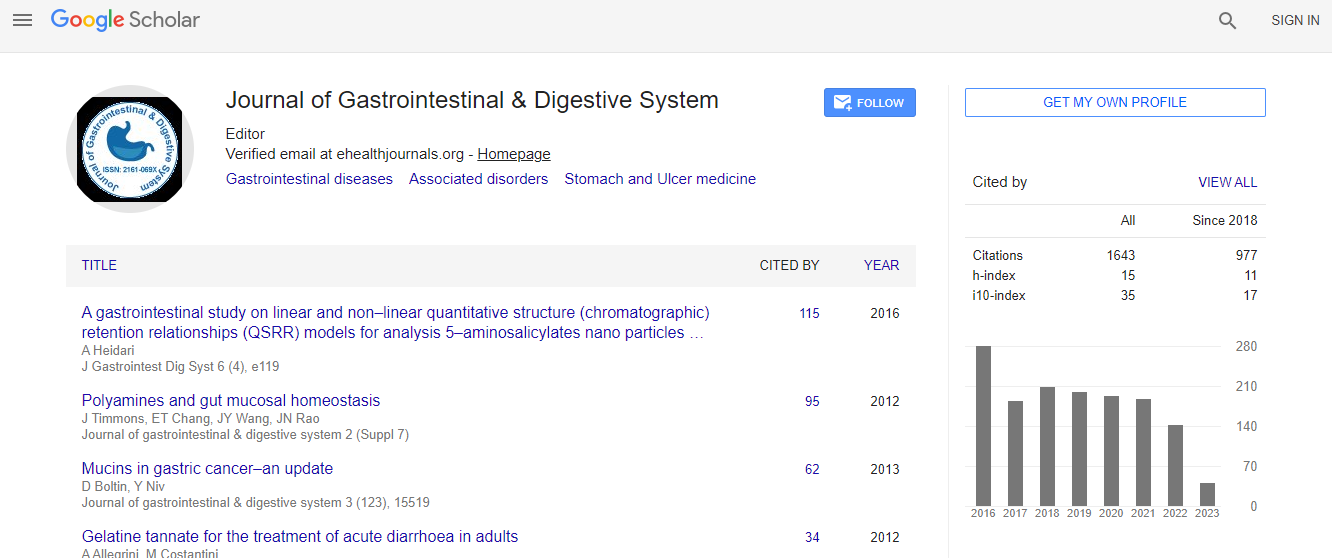Our Group organises 3000+ Global Conferenceseries Events every year across USA, Europe & Asia with support from 1000 more scientific Societies and Publishes 700+ Open Access Journals which contains over 50000 eminent personalities, reputed scientists as editorial board members.
Open Access Journals gaining more Readers and Citations
700 Journals and 15,000,000 Readers Each Journal is getting 25,000+ Readers
Google Scholar citation report
Citations : 2091
Journal of Gastrointestinal & Digestive System received 2091 citations as per Google Scholar report
Journal of Gastrointestinal & Digestive System peer review process verified at publons
Indexed In
- Index Copernicus
- Google Scholar
- Sherpa Romeo
- Open J Gate
- Genamics JournalSeek
- China National Knowledge Infrastructure (CNKI)
- Electronic Journals Library
- RefSeek
- Hamdard University
- EBSCO A-Z
- OCLC- WorldCat
- SWB online catalog
- Virtual Library of Biology (vifabio)
- Publons
- Geneva Foundation for Medical Education and Research
- Euro Pub
- ICMJE
Useful Links
Recommended Journals
Related Subjects
Share This Page
Intestinal parasitosis in relation to CD4+T cells levels and anemia among HAART initiated and HAART na�¯ve pediatric HIV patients in model ART center, Addis Ababa, Ethiopia
International Conference on Pediatric Gastroenterology and Pediatric Practices
Hylemariam Mihiretie, Bineyam Taye and Aster Tsegaye
Wollega University, Ethiopia Addis Ababa University, Ethiopia
Posters & Accepted Abstracts: J Gastrointest Dig Syst
Abstract
Background: Intestinal parasites (IPs) are major concerns in most developing countries where HIV/AIDS cases are concentrated and almost 80% of AIDS patients die of AIDS-related infections. In the absence of highly active antiretroviral therapy (HAART), HIV/ AIDS patients in developing countries unfortunately continue to suffer from the consequences of opportunistic and other intestinal parasites. The aim of the study was to determine the prevalence of intestinal parasites in relation to CD4+ T cells levels and anemia among HAART initiated and HAART na�¯ve pediatric HIV patients in a Model ART center in Addis Ababa, Ethiopia. Methods: A prospective comparative cross-sectional study was conducted among HAART initiated and HAART naive pediatric HIV/AIDS patients attending a model ART center at Zewditu Memorial Hospital between August 05, 2013 and November 25, 2013. A total of 180 (79 HAART initiated and 101 HAART na�¯ve) children were included by using consecutive sampling. Stool specimen was collected and processed using direct wet mount, formol-ether concentration and modified Ziehl-Neelsen staining techniques. A structured questionnaire was used to collect data on socio-demographic and associated risk factors. CD4+ T cells and complete blood counts were performed using BD FACScalibur and Cell-Dyn 1800, respectively. The data was analyzed by SPSS version 16 software. Logistic regressions were applied to assess any association between explanatory factors and outcome variables. P values < 0.05 were taken as statistically significant. Results: The overall prevalence of IPs was 37.8% where 27.8% of HAART initiated and 45.5% of HAART naive pediatric HIV/AIDS patients were infected (p<0.05). Cryptosporidium species, E. histolytica/dispar, Hook worm and Taenia species were IPs associated with CD4+ T cell counts <350 cells/�¼L in HAART naive patients. The overall prevalence of anemia was 10% in HAART and 31.7% in non-HAART groups. Hook worm, S. stercoralis and H. nana were helminthes significantly associated with anemia in non-HAART patients [AOR, 95% CI: 4.5(1.3, 15.2), P< 0.05]. The prevalence of IPs in non-HAART patients was significantly associated with eating unwashed/raw fruit [AOR, 95%CI: 6.3(1.2, 25.6), P<0.05], open field defecation [AOR, 95%CI: 9.3(1.6, 53.6), P<0.05] and diarrhea [AOR, 95%CI: 5.2(1.3, 21.3), P<0.05]. IPs significantly increased in rural residents [AOR, 95%CI: 0.4(0.1, 0.9, P<0.05)]. Conclusion: The overall prevalence of intestinal parasites significantly differed by HAART status and Cryptosporidium species were found only in HAART na�¯ve patients with low CD4+ T cell counts. Anemia was also more prevalent and significantly associated with IPs in non-HAART patients. This study identified some environmental and associated risk factors for intestinal parasitic infections. Therefore, Public health measures should continue to emphasize the importance of environmental and personal hygiene to protect HIV/AIDS patients from infections with intestinal parasites and maximize the benefits of HAART.Biography
Email: hylemariam@gmail.com

 Spanish
Spanish  Chinese
Chinese  Russian
Russian  German
German  French
French  Japanese
Japanese  Portuguese
Portuguese  Hindi
Hindi 
